(The Governance of the TRON Ecosystem)- Crypto Academy S4/W7- Homework Post for professor @yohan2on
.jpg)
Hello everyone, I believe you are all well? This assignment is my submission to professor @yohan2on's class on the governance of the Tron ecosystem. The assignment was given as below:
Who are Super Representatives, SR partners, and SR candidates? (The Governance of the TRON Ecosystem)
What’s the difference between DPOS and POS consensus mechanisms?
Write a Step by Step tutorial showcasing how to stake/freeze TRX and vote for SRs

Who are Super Representatives, SR partners, and SR candidates?

The Tron network is a decentralized blockchain that has experienced tremendous growth and adoption since its inception. Now, there is a variety of applications that utilize the Tron blockchain for their operations due to its efficiency, speed, security, and decentralized nature. Information on the Tron network can be verified by any user publicly and cannot be altered for malicious intents. The integrity of data on the platform is, therefore, sustained.
Tron has received wide adoption partly due to its form of consensus, which is the Delegated Proof of State Consensus Mechanism. The DPOS mechanism is more energy-efficient than the Proof of Work consensus mechanism that is the underlying framework of another cryptocurrency. The DPOS is environmentally friendly as the mining of the tokens takes place on virtual machines. The Delegated Proof of Stake mechanism also paves way for distinct forms of governance with regards to the ecosystem of the cryptocurrency.
The main goal of governance in cryptocurrency ecosystems is to reach a democratic opinion on the form of upgrades, parameters, features, and other elements that need to be implemented on the network. Also, one key characteristic of Delegated Proof of Stake mechanism is the presence of validators.
These are individuals who have committed a number of their cryptocurrency holding to the ecosystem as collateral and are selected for the verification of the blocks or operations on the network. A validator who fails to perform the verification when chosen stands the chance of losing some of his staked tokens or coins as a form of punishment. Even worse, some can lose their validator status.
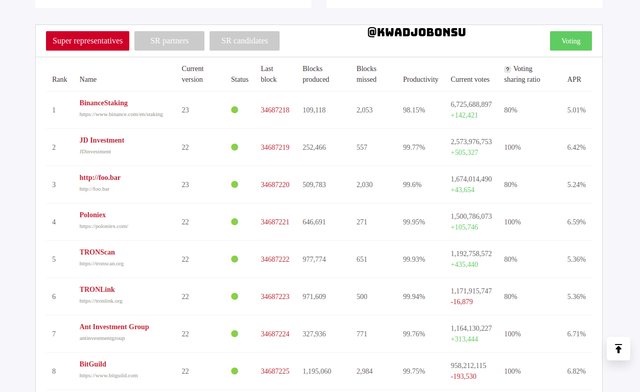
The chosen validators also referred to as Bookkeepers, are limited to a specific number depending on the regulations of a blockchain. Other participants on the network are permitted to vote for these bookkeepers, whose role is to validate blocks of transactions on the network. On the Tron blockchain, the twenty-seven participants who received the highest votes are assigned the Super Representatives role.
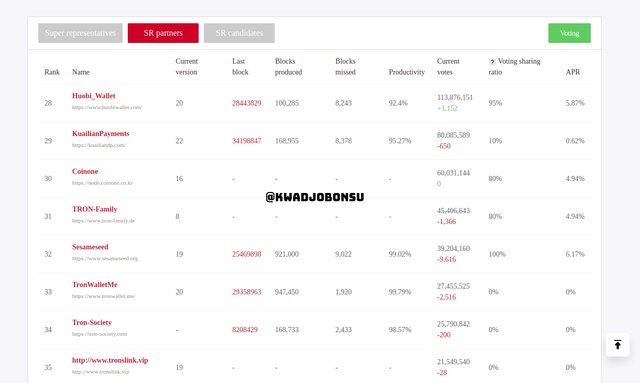
The other candidates who fall between 28 to 127, in order of the highest votes, received, attain the Super Representative Partners role in the Tron ecosystem. The participants from 128 forward are merely alluded to as Super Representative Candidates. The selected SR (Super Representatives) is changed in a specific period. Every six hours the votes are counted, and the SR as well as the other forms of candidates are chosen based on the statistic of the votes.
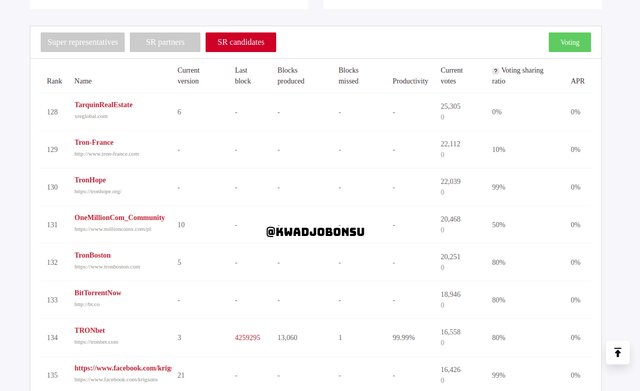
This rotation plays a critical role in ensuring the robust security and operation of the network. The application process demands the burning of 9999 Tron coins of the participant before that individual becomes eligible to vie for the SR role. Successfully selected SR are compensated through an incentive mechanism that is the core of the Tron governance framework.
The Super Representatives are responsible for the production of blocks of transactions on the Tron network. This block generation process takes place every three seconds. Since the rotation of SR takes event every six hours, the last two block production is reserved for such maintenance. This means that within a day, 28800 blocks are generated, out of which 8 are utilized for maintenance purposes. An incentive of 16 TRX is distributed to an SR who successfully produces a block on the blockchain. The other candidates also receive rewards. 160 TRX is disbursed among the highest 127 candidates after one block is generated.
These rewards are distributed to the special accounts of the SR and are not immediate liquid funds. The rewards can only be withdrawn from these subaccounts into the main accounts of the Super Representatives only once a day. Participants who engage in the voting process are also rewarded for their efforts.
The voting process, however, demands a rigorous procedure that needs to be followed despite being open to all Tron users. Before a Tron network participant can obtain a voter status, that account is required to stake at least 1 TRX on the blockchain. A staked or frozen token permits participants to cast one vote. Therefore, the number of frozen TRX is commensurate with the number of votes that can be cast.
A vote, however, becomes nullified when the tokens are unfrozen or unstaked. Alternatively, votes that remain fetch votes eight percent of the annual earnings of the SR that the account voted for. This characteristic, in general, presents an opportunity for both Super Representatives and voters to earn an income from the blockchain through their invested tokens. It also polishes the security and decentralized framework of the blockchain, and these traits make the system safe for developers who deploy their applications on the Tron blockchain as well as users who utilize Tron for their business and personal transactions.

What’s the difference between DPOS and POS consensus mechanisms

Proof Of Stake
POS is one of the commonly used consensus mechanisms in the cryptocurrency space. It addresses some of the inherent problems in the Proof of Work mechanism such as the utilization of high electrical power to create new coins and verify blocks of transactions. In Proof of Stake consensus mechanism, the verification of blocks requires the actions of a group of selected individual who is alluded to as validators.
Before being conferred the validator status, participants must stake their holdings in the ecosystem. These staked resources play a pivotal role in the validator selection process. Thus, the more the staked number of cryptocurrency resources, the more likely that validator will be selected for the block verification task. This also translates to a lower selection chance for validators with a smaller staked amount.
The staked tokens can be burned or taken away if a validator launches a malicious attack on the network or fails to execute the assigned task. Staked tokens in many cryptocurrency networks are able to fetch rewards for the investors. This feature serves as a big motivator for individuals to part take in the act. Furthermore, one big merit of the POS mechanism is that it is environmentally friendly, and projects that embrace this system do not receive crackdowns like projects that utilize the POW consensus mechanism.
Delegated Proof Of Stake
The DPoS consensus mechanism is based on the Proof of Stake mechanism, but it has a slight twist to its function. As its name suggests, there is a form of power delegation involved. With the Delegated Proof of Stake mechanism, participants of a particular network cast votes and select candidates who will be responsible for the production and verification of blocks in the ecosystem of the respective cryptocurrency. The voting mechanism requires participants to stake a certain amount of their cryptocurrency resources in order to be conferred voting rights on the platform.
The number of votes that a user can cast is often proportionate with the number of the staked tokens or coins. Once eligible, the voters will cast votes for the validator of their choice. The number of validators or block producers is usually very limited in number and undergoes regular rotation to strengthen the decentralized framework of the network. Every block has an associated reward, and these rewards are distributed to block producers for their efforts.
Voters are also incentivized for staking their resources and casting votes. The higher the amount of staked resources, the bigger the reward for voters, and the more votes that the individual or account can cast. This consensus mechanism improves upon the decentralized framework of cryptocurrency ecosystems as well as the efficiency of the decision-making process on the network.
| Proof of Stake | Delegated Proof of Stake |
|---|---|
| The validators are selected depending on their staked tokens | The validators are chosen based on the voting statistics of the participants of the network |
| Participants with more staked tokens are prone to being select most of the time | The block validators are selected by voters on the network, and the block producers are reselected based on the voting statistics during a fixated period of time. |
| Block creation speed is lower compared to DPoS | Block production speed is higher than PoS. |
| Validators with higher stakes stand the higher opportunity to earn more | The block producers are assigned a specific amount, and the block creation process rotates from witness to witness. |

Write a Step by Step tutorial showcasing how to stake/freeze TRX and vote for SRs

The TronScan website was used for the demonstration in this section.
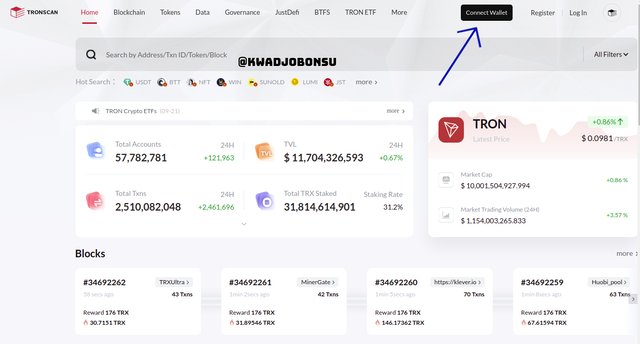
- I clicked on the Connect Wallet button to commence with the process by linking my TronLink wallet to the website.
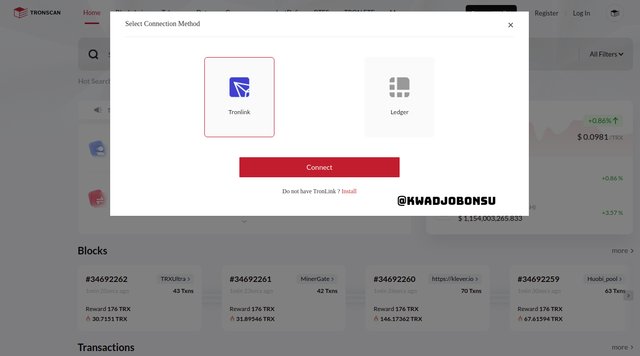
- I selected the TronLink wallet option as the connection method.
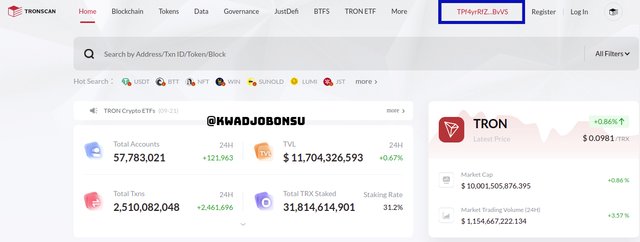
- I had already signed into my TronLink wallet, so the connection was automatic. As highlighted, my account has been linked.
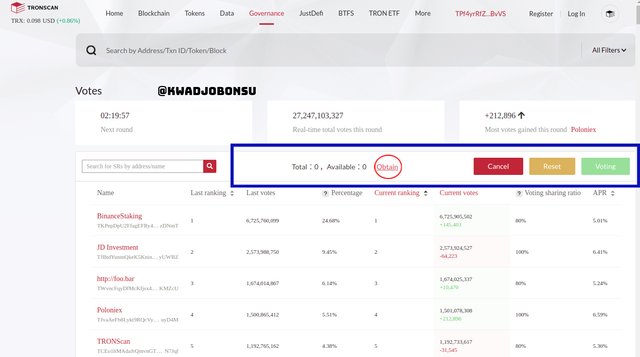
- Next, I navigated to the votes page under the Governance section on the website. To cast votes, I had to obtain voting rights. I clicked on the Obtain button.
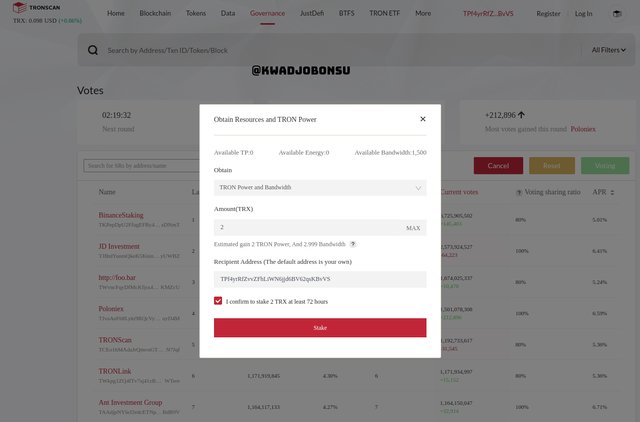
- I entered 2 TRX as the amount to be staked, and I clicked the red Stake button.
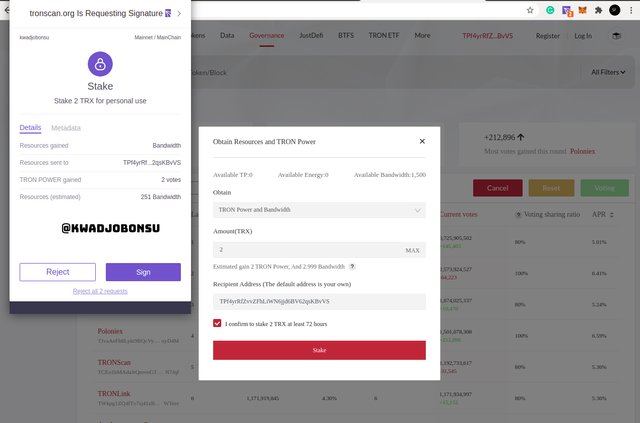
- I agreed to series of confirmations from the TronLink wallet extension.
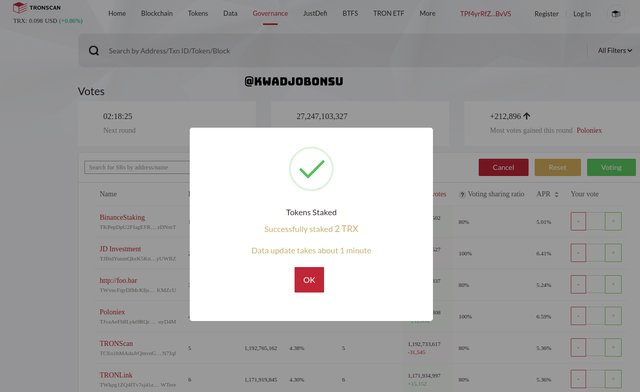
- The Tokens were successfully staked.
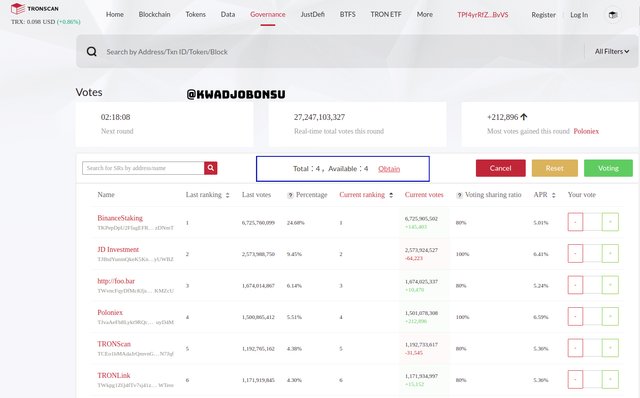
- As shown, a total of 4 votes could be cast, as highlighted.

- I committed 2 TRX to Ant Investment Group, as it had an APY of 6.7%. I later clicked on the Green Voting button to cast the vote.
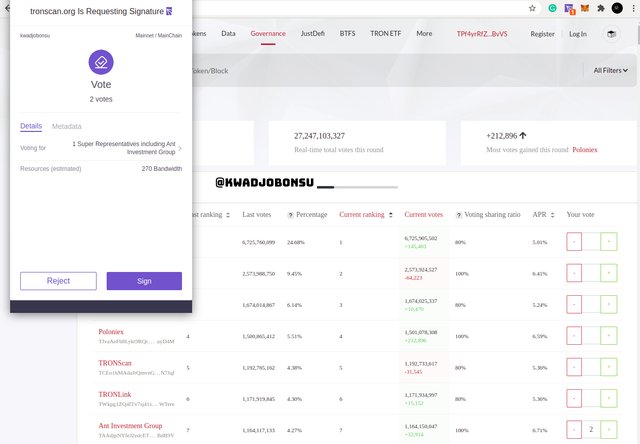
- I confirmed the transaction from the TronLink wallet.
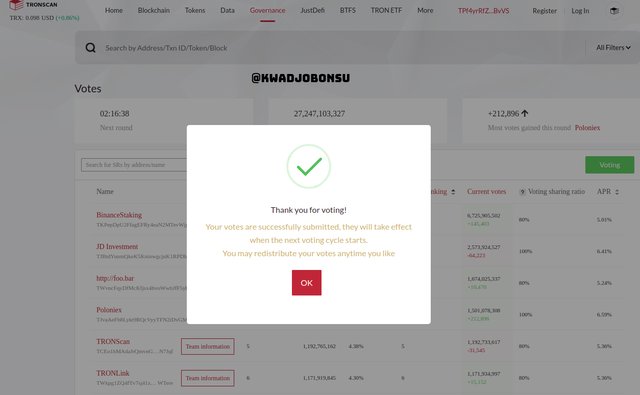
- The voting was successful as indicated in the image above,
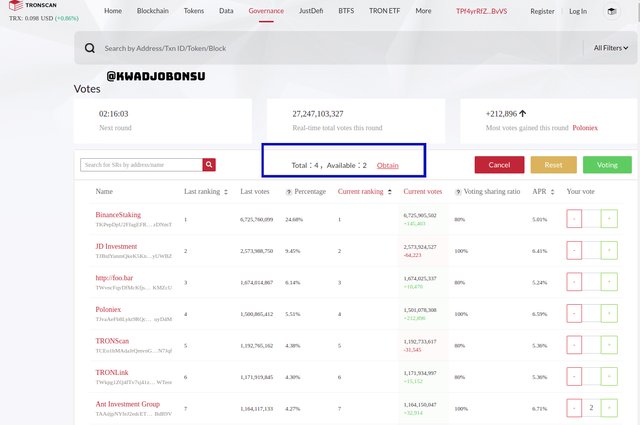
- The available number of vote rights was reduced to 2 according.

Conclusion

The Tron network utilizes the Delegated Proof of Stake mechanism for the governance of its ecosystem. Participants of the network who have staked their tokens are given the authority to cast votes for a select group of candidates. The top 27 votes recipients are called Super Representatives, the accounts between the 28th rank and 127 ranks are alluded to as the Super Representatives Partners, and Super Representative Candidates refer to the participants after the 127th rank, thus 128 forward.
The SRs are responsible for block production and are also permitted to put forth proposals about the network, which will then be vetted by the 27 SRs. Super Representatives as well as the voters receive rewards for their respective contributions towards the development of the democratic and decentralized nature of the ecosystem.
This class was certainly insightful, and I thank Professor @yohan2on for this education.
Hello @kwadjobonsu,
Thank you for participating in the 7th Week Crypto Course in its 4th season and for your efforts to complete the suggested tasks, you deserve a Total|9/10 rating, according to the following scale:
My review :
Work with excellent content, because you have taken every question seriously, allowing you to get answers that are precise and in-depth in its analysis and clear in its methodology.
Note : Please do not use the tag #club5050 if you haven't made a power up for the last seven days or so.
Thanks again for your effort, and we look forward to reading your next work.
Sincerely,@kouba01